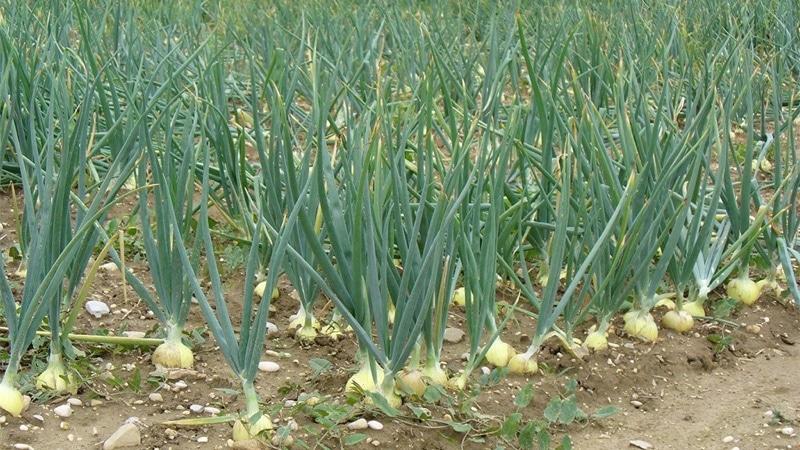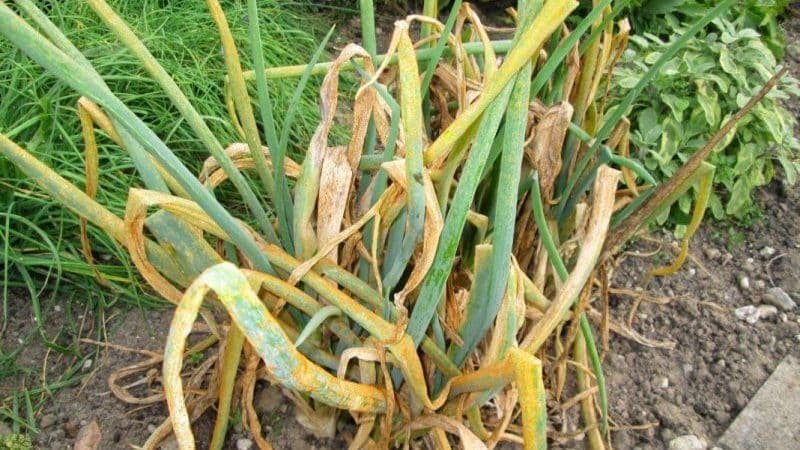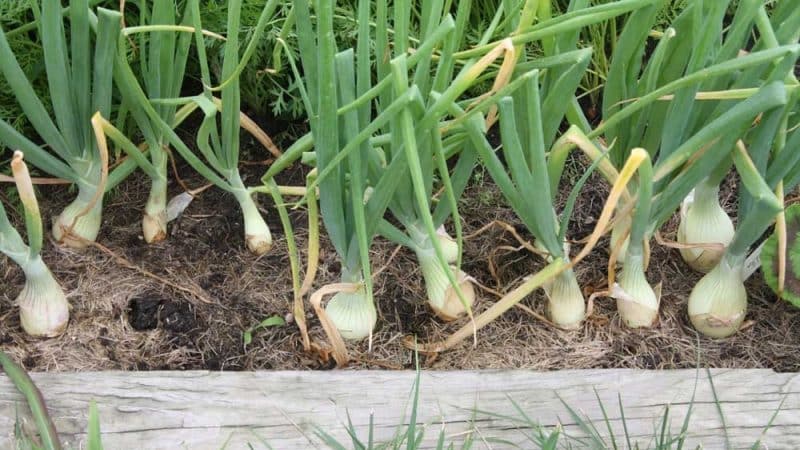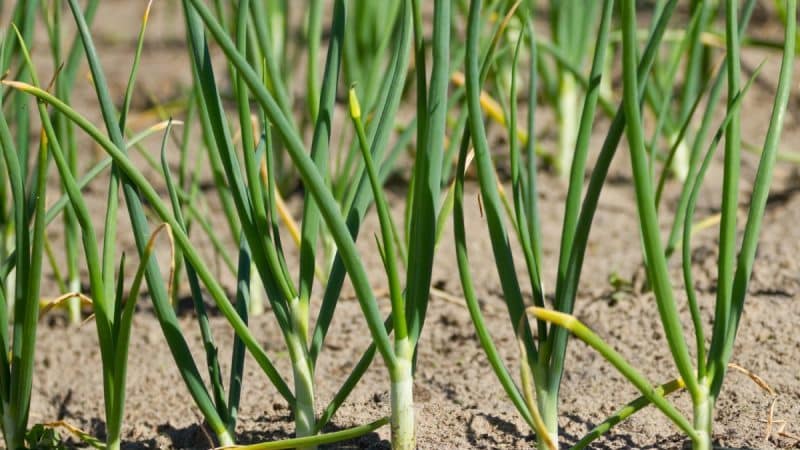What to do if the onions turn yellow in the garden, and why this happens
Yellowed onion feathers at the end of August indicate that it is time to harvest. A cause for concern and emergency measures is yellow onion feathers in spring or summer. Folk remedies or commercial chemicals will help save the harvest in such a situation.
From the article you will learn why onions turn yellow in the garden, how to eliminate and prevent this problem.
The main reasons for yellowing of onions in the garden

Yellowing of the feathers of onions growing in the garden is caused by various factors. Yellow spots and dried ends that appear ahead of schedule are caused by the following reasons:
- damage by insect pests;
- diseases;
- deficiency of substances necessary for plant growth and development;
- unfavorable weather;
- violation of the rules of agricultural technology;
- soil composition.
Diseases
The yellowing of onion feathers is often caused by the defeat of plantings by diseases such as bacterial rot, bottom rot, rust, Alternaria, and yellow viral dwarfism of onions.
Reference. Plant infection by fungi and bacteria is often provoked by the use of low-quality planting material.
Pests
The consequences of insect pest attacks on onion beds are noticeable by yellowed feathers. Plants dry out when they are damaged:
- onion moth;
- tobacco thrips;
- onion secretive proboscis;
- stem nematode;
- weevil;
- onion fly.
Nutritional deficiencies
When growing vegetables in infertile soil, yellowness of onion feathers is also observed. The problem is caused by a deficiency of certain substances, in particular nitrogen.
Reference. With a lack of nitrogen, onions in the beds not only turn yellow, but also die.
Improper care
Violating the rules of onion agricultural technology is fraught with the appearance of yellowness. The culture is not considered capricious in terms of care, however, with gross agrotechnical errors, the onions will begin to turn yellow and dry out.
Important. To onion landing is not lost, choose the right place for the garden bed, water the plants regularly, use fertilizing. The rules of care are determined by the varietal of the onion.
Adverse weather conditions

Drought is often the cause of yellowing onions. In the absence of precipitation in the form of rain and properly organized watering, the process of sap flow fails. The plants continue to gain mass, but the feathers begin to turn yellow and dry out.
Frost can also cause a problem. Yellowness affects plants if they were planted in open ground ahead of schedule and exposed to low temperatures.
Soil composition
Acidic soil provokes the appearance of yellowish tips or spots on onion feathers. The vegetable loves fertile, loose soil with a neutral and alkaline reaction.
Diseases that can cause yellowing and methods to combat them
Onion planting are affected by diseases (bacteria, fungi, viruses) due to violation of the rules of agricultural technology. To save the crop, you need to figure out how to deal with diseases that lead to yellowing and death of plants.
Rust
Rust is a fungal infection that manifests itself as spot yellowing and the formation of bulges on the onion.The first symptoms appear in May-June. Over time, the diseased plant begins to turn black and lose leaves.
Only prevention will save you from rust:
- compliance with the rules crop rotation;
- warming up the planting material on the eve of storage;
- warming up the seedlings for 12 hours at a temperature of + 40°C before planting in open ground;
- spraying plants with copper oxychloride (1 tablespoon of the drug is dissolved in 10 liters of soap solution), followed by treatment with the drug “HOM”, carried out after 7 days.
Bottom Rot
Bottom rot threatens all species and varieties onions. This is damage to the bulb by the Fusarium fungus that lives in the soil. Diseased plants turn yellow and die.
Compliance with the rules of vegetable agricultural technology will protect you from the problem. Prevention consists of:
- choosing the right place for the garden bed - it should not be subject to flooding;
- planting onions in an area where cereal grains were previously grown;
- disinfection of sets and seeds with a fungicide like “Fundazol”;
- planting in the garden on time;
- proper storage of the crop.
It is possible to combat bottom rot that has affected onion plantings only in the early stages of the disease. Treating the beds with a solution of copper oxychloride will help.
Alternaria blight
Signs of onion damage by Alternaria include:
- whitish spots on the leaves, becoming concentric over time;
- breaking and drying of feathers with spots;
- the appearance of a gray-black coating if there is high humidity.
Old feathers are more susceptible to fungal infection. The disease leads to blackening of the leaves, damage to the bulb - its wateriness increases, and a brownish coating appears between the layers.
They fight the problem with the drugs “Acrobat”, “Cabrio Duo”, “Poliram”, “Fitosporin”.
Onion yellow virus dwarfism
Symptoms of the disease:
- the appearance of yellowish stripes, curvature of feathers;
- complete yellowing of feathers;
- deformation of plants and the bulb itself;
- absence of fruits on the testes.
The disease can completely destroy the planting. The virus is stored in the bulb.
Methods of protection against the virus:
- aphid control;
- tool processing;
- separation of onion beds by other representatives of the subfamily;
- removal of affected plants.
Pests

A common cause of yellowing onions in the garden is insect attacks. To save the harvest, consider methods of pest control.
Onion moth
Onion moths, which look like a small brown butterfly, are found by gardeners in the garden at the end of spring. She lays larvae, which, becoming caterpillars, eat the plants.
Prevention of the problem is:
- in planting seedlings in the early stages, allowing harvesting before the pest becomes active;
- use of fertilizers belonging to the insecticidal series;
- competent choice of “neighbors” in the garden.
They fight onion moths by treating the bed with insecticides like “Iskra”.
Thrips
Onion (tobacco) thrips are tiny pests. The length of their body is up to 1 mm. The insect is dangerous not only for onion planting, but also for other garden and vegetable crops. Whitish spots appear on the affected onion, which subsequently merge, and the leaves themselves fade.
The fight against thrips involves spraying the beds with insecticides “Iskra”, “Confidor”, etc.
For prevention, planting material is disinfected with hot water: the bulbs are immersed in water at a temperature of +45°C for 10 minutes.Then the seeds are washed with cold water.
Plants that have already been infected by thrips are burned.
Onion fly
The onion fly invasion is observed in early spring (April - May). The main symptom is yellowing of the tips of the feathers. If you dig up a vegetable, you can see that the fruit itself has rotted.
It is easier to scare away a carrot fly from the beds than to fight it. Pollinating the rows with a mixture of tobacco dust and sunflower ash, taken in a 1:1 ratio, will help. Affected bulbs are dug up and destroyed.
Stem nematode
Yellowing and wrinkling of onion feathers is a symptom of an attack on the plant by a stem nematode. If you rip open the affected leaf, you will see small thread-like white worms in the middle.
Nematode control measures include preventive treatment of seedlings and soil before planting. In the summer, when the parasite larvae move from the bulb to the feather, it is necessary to immediately burn the diseased plants so that the entire harvest is not lost.
Weevil
If yellowing of the feather is observed, and passages are visible through the plant film, it means that the leaf from the inside is being eaten by the larvae of the onion secretive proboscis (weevil). They look like yellowish-white caterpillars with a brown head. The parasite reaches 7 mm in length.
If bugs are found on the onion bed, they are collected from the leaves before they lay eggs. A deterrent measure is mulching the soil with ash. When beetles spread, the bed is treated with Karbofos.
Plants damaged by the larvae are burned.
Lack of nutrients in the soil

Nitrogen deficiency often causes yellowing of onion feathers. This happens if humus or compost was not added to the soil on the eve of planting.
Nitrogen deficiency is determined by the appearance of plants.The leaves become faded, the fruits become small.
To compensate for the lack of nitrogen, feed the plants with mullein:
- Dissolve 200 g of this natural fertilizer in 10 liters of water, adding 1 tablespoon of urea to the resulting solution.
- The resulting product is used for glaze beds (consumption 2-3 liters per 1 m²). The procedure is repeated after 2 weeks if necessary.
You cannot feed plants with mullein solution more than 3 times a season.
Nettle infusion will also help solve the problem:
- Soak 200-500 g of raw material in 10 liters of water and infuse for 1 week.
- The infusion is filtered and used for watering the beds, after diluting it with water in a ratio of 1:10.
Root feeding with this product can be used once a week, foliar feeding (spraying leaves) - no more than once a month.
Failure to comply with care rules
Errors in care sometimes lead to yellowing of plants in the garden. One of them is improper watering of onion beds.
To avoid the problem, water the onions once every 3 days when the crop begins to grow, before noon. Water with a temperature of +18 to +25°C is poured under the root.
Reference. It is advisable to combine watering with fertilizing. It is recommended to dissolve ammonium nitrate, superphosphate, and potassium salt in water. The plants are fed the first time when they reach a height of 3 cm, the second time – after 7 days.
Yellowing of onions is caused by an excess of weeds that take nutrients from the soil. Regular weeding will prevent this.
Loosening after each watering also prevents yellow spots from appearing on onions. The procedure enriches the soil with oxygen and helps destroy onion fly eggs.
Unsuitable weather conditions
Drought causes yellowing of onions in the garden. The problem can be solved with additional watering.You will need to water the bed daily, monitoring the soil moisture level.
Traditional recipes to combat yellowing
Folk remedies will help solve the problem of yellowing and drying onion feathers caused by pests:
- Saline solution. Dissolve 200 g of salt in a bucket of water, add a little ammonia and 3 handfuls of ash. The product is watered between the rows, then the soil is loosened. It cannot be used often - only 2-3 times per season. Apply once every 10-15 days until the onion feather turns green.
- Soda solution. Dissolve 100 g of soda, 1 tbsp in a bucket of water. l. iodine and add 2-3 bags of potassium permanganate. The product is used for watering beds, after diluting it with water in a ratio of 1:10. One plant will require no more than 1 cup of solution. When watering, avoid getting the product on the leaves.
- Infusion of wormwood, dandelion, calendula. The bucket is filled halfway with herbs and filled with warm water. Infuse in a dark place for 2 days, then filter. Dilute with water in a ratio of 1:10 and add a little liquid soap. Spray the garden bed with the resulting product, avoiding contact with the leaves. Plants affected by pests are treated with herbal infusion no more than 3-5 times per season.
An excellent preventive measure is sprinkling the rows with wood ash, tobacco dust, and ground pepper.
Anti-yellowing chemicals
The use of chemicals for spraying onions (Confidor, Mospilan, Karate, Aktara, Karbofos) will help solve the problem caused by pests.
To combat fungal diseases, the drugs “HOM”, “Gamair” and “Fitosporin-M” are used.
Important. Onions cannot be treated with chemicals. This is done to obtain full-fledged bulbs.
Prevention measures
The best way to prevent the problem of yellowing of onions is prevention, which consists of following the rules of agricultural practices.
Experienced gardeners recommend:
- do not return to growing onions in the old plot earlier than after 4 years;
- grow a crop after pumpkin, zucchini, potatoes, beans, peas, tomatoes;
- carry out pre-sowing treatment of seedlings;
- do not compact the planting with carrots so that it does not inhibit the growth of onions;
- take care of fertilizing;
- place the bed in a sunny and ventilated place where water does not stagnate;
- regularly weed and loosen the beds;
- observe the watering regime - several times a week, 10 liters per 1 m²;
- Harvest the crop on time and dry it.
Conclusion
Yellowing of onion feathers is caused by many reasons: from damage to the vegetable crop by diseases and pests to violation of the rules of agricultural technology. Proper care and timely use of folk remedies or purchased drugs will help to cope with the problem and save the harvest.